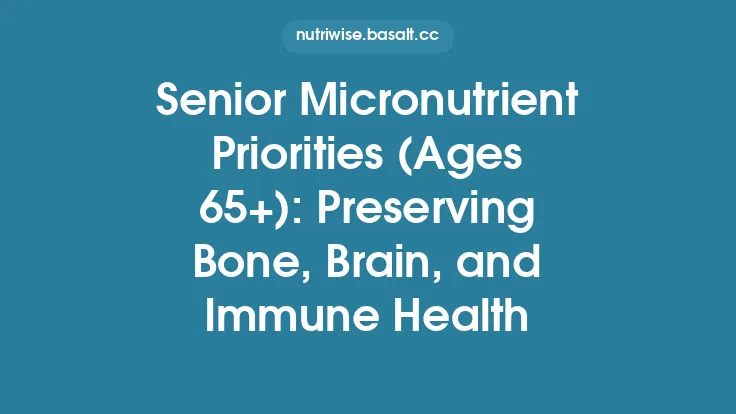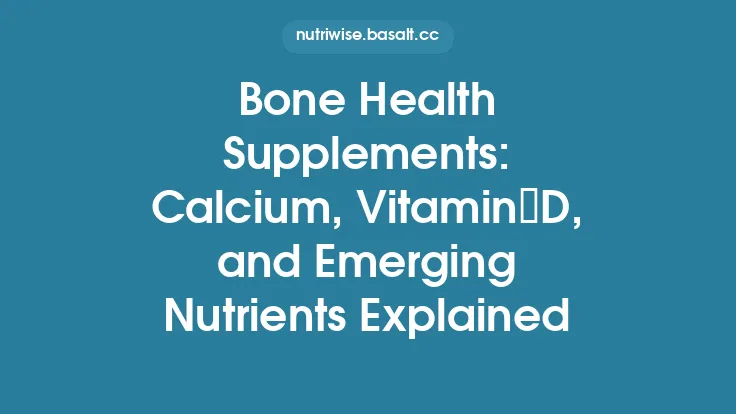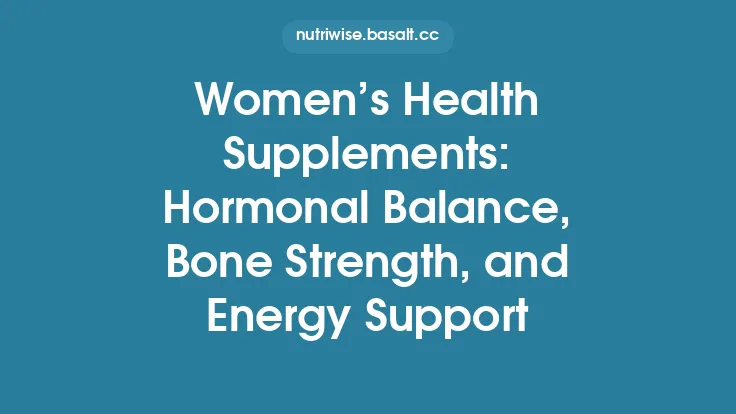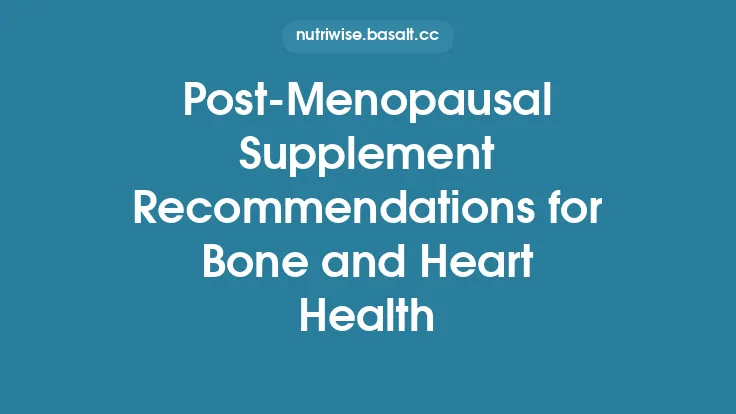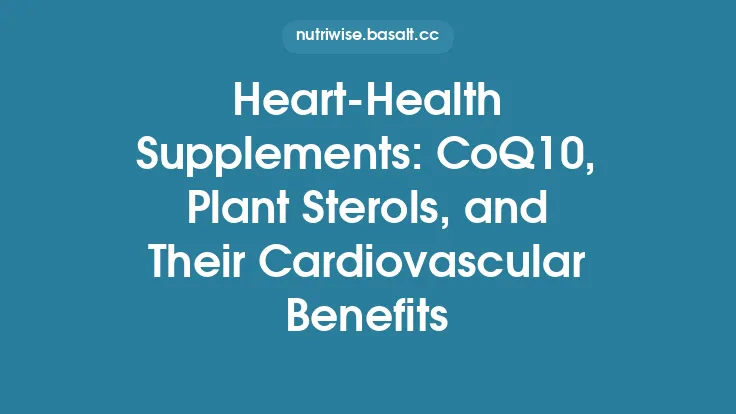Aging brings a natural shift in how the body absorbs, utilizes, and stores nutrients. For many seniors, maintaining strong bones, a resilient cardiovascular system, and sharp cognitive function becomes a central health priority. While a balanced diet remains the foundation, certain micronutrients and bioactive compounds can fill gaps that often emerge with age, support physiological processes that tend to decline, and help preserve quality of life. Below is a comprehensive look at the most evidence‑backed supplements that target bone, heart, and brain health in older adults, along with practical guidance on how to incorporate them safely and effectively.
Understanding Age‑Related Nutrient Shifts
- Reduced Gastrointestinal Absorption – Stomach acid production wanes, and intestinal transport proteins become less efficient, leading to lower uptake of calcium, vitamin B12, iron, and magnesium.
- Altered Hormonal Landscape – Declines in sex hormones, growth hormone, and insulin‑like growth factor‑1 (IGF‑1) affect bone remodeling, lipid metabolism, and neuronal plasticity.
- Increased Oxidative Stress – Mitochondrial efficiency drops, generating more reactive oxygen species (ROS) that can damage vascular endothelium and neuronal membranes.
- Changes in Body Composition – Loss of lean muscle mass (sarcopenia) and a modest increase in fat mass influence the distribution and storage of fat‑soluble vitamins (A, D, E, K).
These physiological trends create a predictable pattern of nutrient shortfalls that can be mitigated with targeted supplementation.
Core Nutrients for Bone Health
| Nutrient | Primary Role | Typical Senior Dose* | Key Food Sources |
|---|---|---|---|
| Calcium | Provides the mineral scaffold for bone matrix; essential for osteoblast activity. | 1,000 mg (1,200 mg for >70 y) | Dairy, fortified plant milks, leafy greens |
| Vitamin D (D₃) | Enhances intestinal calcium absorption; modulates bone turnover hormones (PTH). | 800–2,000 IU daily (based on serum 25(OH)D) | Sunlight, fatty fish, fortified foods |
| Magnesium | Cofactor for enzymes that convert vitamin D to its active form; supports crystal formation. | 320–420 mg daily | Nuts, seeds, whole grains |
| Vitamin K₂ (MK‑7) | Directs calcium to bone and away from arteries by activating osteocalcin and matrix Gla‑protein. | 90–120 µg daily | Natto, hard cheeses, fermented foods |
| Boron | Influences calcium and magnesium metabolism; may increase estrogen and testosterone levels modestly. | 1–3 mg daily | Fruits, nuts, legumes |
| Omega‑3 (EPA/DHA) | Reduces inflammation that can accelerate bone resorption; may improve calcium balance. | 500–1,000 mg EPA + DHA combined | Fatty fish, algae oil |
| High‑Quality Protein | Supplies amino acids for collagen synthesis and osteoblast function. | 1.0–1.2 g/kg body weight per day | Lean meats, dairy, legumes, soy |
*Doses reflect common recommendations for healthy seniors; individual needs may vary.
Why these matter together: Calcium and vitamin D are the classic duo, but without adequate magnesium, vitamin K₂, and protein, the skeleton cannot efficiently mineralize. Boron and omega‑3s add anti‑resorptive and anti‑inflammatory benefits that become increasingly valuable with age.
Cardiovascular Support Supplements
- Omega‑3 Fatty Acids (EPA & DHA)
*Mechanism:* EPA competes with arachidonic acid, lowering pro‑inflammatory eicosanoids; DHA improves membrane fluidity in endothelial cells, supporting nitric‑oxide production.
*Evidence:* Meta‑analyses show a modest reduction in triglycerides (≈15 %) and a lower risk of major adverse cardiovascular events when EPA + DHA intake exceeds 1 g/day.
- Coenzyme Q10 (Ubiquinol)
*Mechanism:* Serves as a mitochondrial electron carrier and a potent antioxidant; levels decline ~50 % after age 60.
*Evidence:* Randomized trials in older adults demonstrate improved endothelial function (↑ flow‑mediated dilation) and reduced systolic blood pressure when 100–200 mg/day of ubiquinol is taken.
- Magnesium
*Mechanism:* Regulates vascular tone, calcium channel activity, and arrhythmogenic potential.
*Evidence:* Observational data link higher dietary magnesium with lower incidence of coronary artery disease; supplementation (300–400 mg/day) can modestly lower blood pressure.
- Potassium‑Rich Supplements (e.g., potassium citrate)
*Mechanism:* Counteracts sodium‑induced hypertension, promotes vasodilation, and reduces arterial stiffness.
*Evidence:* Clinical trials show a 2–3 mmHg drop in systolic pressure with 40–80 mmol/day of supplemental potassium, provided renal function is intact.
- Plant Sterols & Stanols
*Mechanism:* Compete with cholesterol for intestinal absorption, lowering LDL‑C by ~10 %.
*Evidence:* Daily intake of 2 g of sterols/stanols consistently reduces LDL‑C in older populations without affecting HDL‑C.
- Vitamin K2 (MK‑7)
*Mechanism:* Activates matrix Gla‑protein, a potent inhibitor of vascular calcification.
*Evidence:* Long‑term supplementation (≥120 µg/day) correlates with slower progression of coronary artery calcium scores.
- Fiber (Soluble, e.g., psyllium, β‑glucan)
*Mechanism:* Binds bile acids, prompting hepatic conversion of cholesterol to bile acids, thereby lowering serum LDL.
*Evidence:* 10 g/day of soluble fiber can reduce LDL‑C by 5–7 % in seniors.
Cognitive Health Boosters
| Supplement | Cognitive Target | Typical Dose | Supporting Mechanism |
|---|---|---|---|
| DHA (Omega‑3) | Membrane fluidity, synaptic plasticity | 500–1,000 mg EPA + DHA (≥300 mg DHA) | Provides essential phospholipids for neuronal membranes; reduces neuroinflammation |
| B‑Vitamins (B6, B9‑folate, B12) | Homocysteine metabolism, neurotransmitter synthesis | B6 = 25 mg; Folate = 400–800 µg; B12 = 500–1,000 µg | Lower homocysteine, a risk factor for cognitive decline; support methylation cycles |
| Vitamin D | Neuroprotection, neurotrophic factor regulation | 800–2,000 IU | Modulates neuroimmune response; deficiency linked to poorer executive function |
| Vitamin E (mixed tocopherols) | Antioxidant protection of lipid‑rich brain tissue | 200 IU (≈134 mg) | Scavenges ROS, reduces oxidative damage to neuronal membranes |
| Curcumin (phytosomal or BCM‑95®) | Anti‑inflammatory, amyloid‑beta aggregation inhibition | 500–1,000 mg daily (enhanced bioavailability) | Inhibits NF‑κB pathway; may improve memory scores in mild cognitive impairment |
| Phosphatidylserine | Membrane integrity, signal transduction | 100–300 mg daily | Enhances acetylcholine release; improves attention and working memory |
| Ginkgo biloba (standardized EGb 761) | Cerebral blood flow, antioxidant activity | 120–240 mg daily | Increases microcirculation; may modestly improve processing speed |
| Acetyl‑L‑carnitine | Mitochondrial energy production, neuroplasticity | 500–1,000 mg daily | Facilitates fatty‑acid transport into mitochondria; supports neuronal energy metabolism |
Synergistic considerations: Combining DHA with phosphatidylserine or curcumin can amplify membrane stability and anti‑inflammatory effects. B‑vitamin complexes are most effective when taken with adequate folate and B12, especially because absorption of B12 declines with age.
Integrative Approach: Combining Supplements Safely
- Assess Baseline Status – A simple blood panel (25‑OH vitamin D, serum calcium, magnesium, B12, lipid profile, homocysteine) helps identify true deficiencies and prevents unnecessary excess.
- Prioritize Whole‑Food Sources – Supplements should complement, not replace, a diet rich in leafy greens, fatty fish, nuts, seeds, and whole grains.
- Mind the Timing
- Calcium can interfere with iron and zinc absorption; separate calcium (with meals) from iron‑rich foods or supplements.
- Fat‑soluble vitamins (D, K2, E) are best taken with a meal containing dietary fat.
- CoQ10 and curcumin benefit from concurrent intake of a small amount of fat for enhanced absorption.
- Watch for Interactions –
- High-dose vitamin K2 may affect anticoagulant therapy (e.g., warfarin).
- Omega‑3s can potentiate the antiplatelet effect of aspirin or NSAIDs.
- Magnesium can cause mild diarrhea at high doses; split into two smaller doses if needed.
- Start Low, Go Slow – Introduce one new supplement at a time, monitor tolerance, and adjust dosage over 2–4 weeks before adding another.
Practical Tips for Choosing Quality Supplements
- Third‑Party Verification – Look for NSF International, USP, or Informed‑Sport certifications that confirm label accuracy and absence of contaminants.
- Form Matters –
- Calcium citrate is more readily absorbed than calcium carbonate, especially in low‑acid environments.
- Magnesium glycinate or malate have higher bioavailability and fewer laxative effects than magnesium oxide.
- Vitamin D₃ (cholecalciferol) is superior to D₂ for raising serum 25‑OH D levels.
- For omega‑3s, choose triglyceride or re‑esterified forms; ethyl‑ester oils have lower absorption.
- Transparent Labeling – The label should list the exact amount of active ingredient per serving, the source (e.g., marine fish oil, algae), and any added excipients (e.g., soy, gelatin).
- Shelf Stability – Antioxidants (e.g., vitamin E) and opaque, airtight containers protect omega‑3s from oxidation.
Lifestyle Factors that Amplify Supplement Benefits
| Factor | How It Enhances Supplement Efficacy |
|---|---|
| Weight‑Bearing Exercise | Stimulates osteoblast activity, making calcium and vitamin K2 more effective for bone formation. |
| Aerobic Activity | Improves endothelial function, synergizing with omega‑3s and CoQ10 for cardiovascular health. |
| Adequate Sun Exposure (10–15 min mid‑day, 2–3 times/week) | Boosts endogenous vitamin D synthesis, reducing the required supplemental dose. |
| Balanced Macronutrients (30 % protein, 45 % carbs, 25 % fat) | Provides the necessary cofactors (e.g., dietary fat for fat‑soluble vitamins) and supports overall nutrient absorption. |
| Sleep Hygiene (7–8 h/night) | Enhances hormonal regulation (growth hormone, melatonin) that supports bone remodeling and neuroplasticity. |
| Hydration | Facilitates renal clearance of excess minerals, preventing hypercalcemia or magnesium overload. |
Bottom Line
For seniors aiming to preserve skeletal strength, cardiovascular resilience, and mental acuity, a focused supplement regimen—grounded in current scientific evidence—can bridge age‑related nutrient gaps and reinforce the body’s natural defense mechanisms. The most impactful combination includes:
- Calcium + Vitamin D₃ + Magnesium + Vitamin K2 for bone health.
- Omega‑3 EPA/DHA + CoQ10 + Plant Sterols + Potassium for heart health.
- DHA + B‑Vitamin Complex + Vitamin D + Curcumin + Phosphatidylserine for cognitive vitality.
When paired with a nutrient‑dense diet, regular physical activity, and routine health monitoring, these supplements become powerful tools for aging gracefully. Always consult a healthcare professional before initiating any new supplement, especially when prescription medications or chronic health conditions are present. With thoughtful selection and consistent use, seniors can enjoy stronger bones, a healthier heart, and a sharper mind for years to come.
